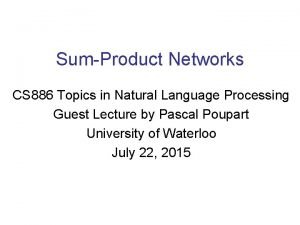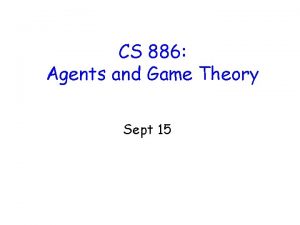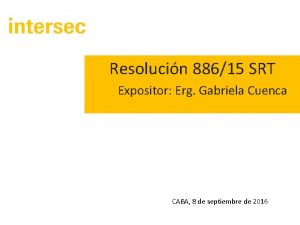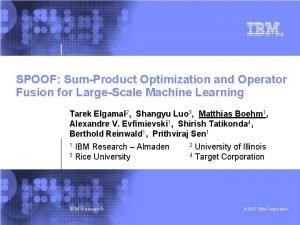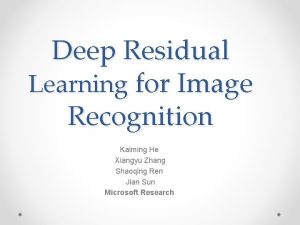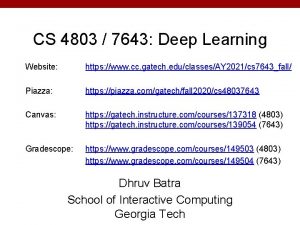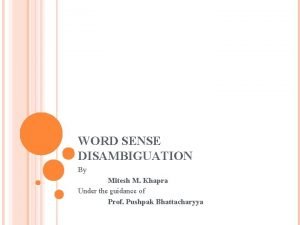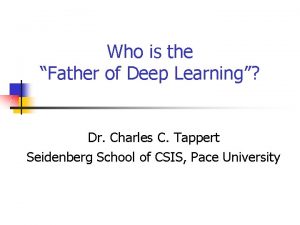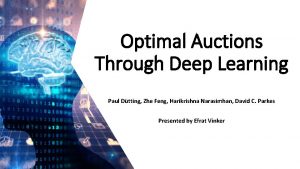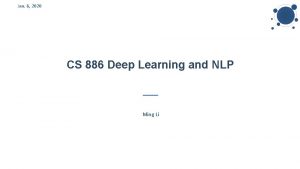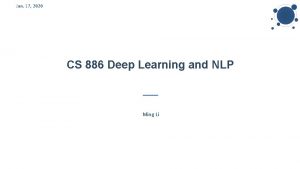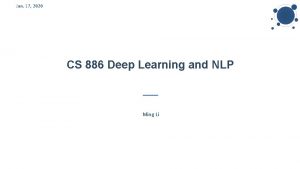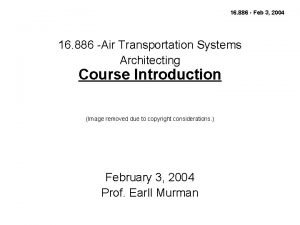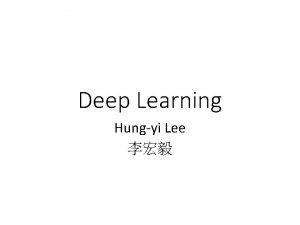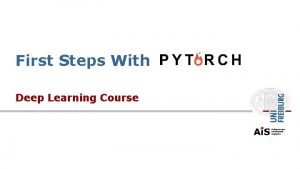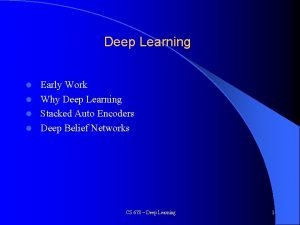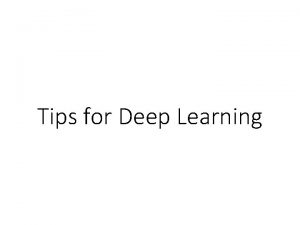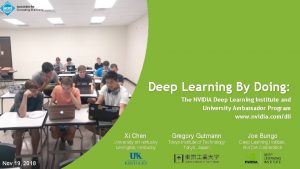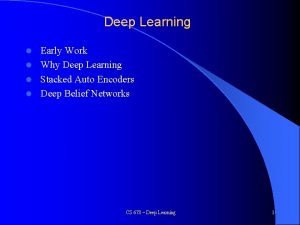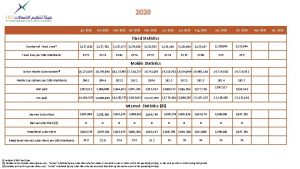Jan 17 2020 CS 886 Deep Learning and






















- Slides: 22

Jan. 17, 2020 CS 886 Deep Learning and NLP Ming Li

01. Word 2 Vec 02. Attention / Transformers CONTENT 03. GPT and BERT 04. Simplicity, ALBERT and SHA-RNN 05. Student presentations 06. Student project presentations 07.

04 Theory of Simplicity Last two lectures: The bigger the better! This lecture: The smaller the better!

04 Theory of Simplicity, ALBERT and SHA-RNN LECTURE FOUR

04 Theory of Simplicity Plan 1. Why simpler? 2. ALBERT 3. SHA-RNN

04 Theory of Simplicity The Importance of being small 1. Occam’s Razor: Entities should not be multiplied beyond necessity. 2. I. Newton: Nature is pleased simplicity

04 Theory of Simplicity One example: Inferring a DFA l Given data that a DFA accepts: 1, 11111, 1111111; and rejects: 11, 111111. What is it? 1 1 1 1 l There actually infinitely many DFAs satisfying these data. l The first DFA makes a nontrivial inductive inference, l The 2 nd does not. It “over fits” the data, can’t make further predictions.

04 Theory of Simplicity History of Science Maxwell's (1831 -1879)'s equations say that in 1865: • (a) An oscillating magnetic field gives rise to an oscillating electric field; • (b) an oscillating electric field gives rise to an oscillating magnetic field. Item (a) was known from M. Faraday's experiments. However (b) is a theoretical inference by Maxwell and his aesthetic appreciation of simplicity. The existence of such electromagnetic waves was demonstrated by the experiments of H. Hertz in 1888, 8 years after Maxwell's death, and this opened the new field of radio communication. Maxwell's theory is even relativistically invariant. This was long before Einstein’s special relativity. As a matter of fact, it is even likely that Maxwell's theory influenced Einstein’s 1905 paper on relativity which was actually titled `On the electrodynamics of moving bodies’.

04 Theory of Simplicity Bayesian Inference Bayes Formula: P(H|D) = P(D|H)P(H)/P(D) Take -log, maximize P(H|D) becomes minimize: -log. P(D|H) – log P(H) (modulo log. P(D), constant). Where, by Shannon-Fano Theorem, -log P(D|H) is the coding length of D given H. -log P(H) is the coding length of model H Thus, to maximize the probability is the same as minimizing the model length (and error description length).

04 Theory of Simplicity PAC Learning theory / Statistical Inference Given a set of data, if you have a model to fit the data, then the smaller the model is, the more likely it is to be correct. Such a statement can be proved formally, but it is not our focus here. The key message I wish to deliver is: if you can do the same work with a smaller (neuron network) model, it will be most likely better.

04 Theory of Simplicity We have studied Transformer, GPT-2, and especially BERT. Input/output vector size 768 or

04 Theory of Simplicity We have observed: The bigger model we get better results. However, we have just learned theory: the smaller the model is, the more likely we are close to ground truth. So, what is the problem? Could it be that “the ground truth model” is large? But how much data have we used to train a human kid? At 150 wpm (average speech speed), a human child of 10 year old has heard: 150 x 30 (min) x 5 (hours) x 365 (days) x 10 (years) ≈ 80 M words BERT used: 2500 M words from Wikipedia, and 11, 038 books (1000 M words) = 3500 M words, 43 times of human kid. At least, this shows the ground truth model is not that large. We should search for smaller models. Research project: what is the size of human language model? (Create a pseudo model to test BERT vs SHA-RNN)

04 Theory of Simplicity ALBERT 1. Separate word embedding size (128 now) from hidden layer vector size (768). This saves Vx(768 -128) weights. 2. Cross-layer parameter sharing: including attention part and feed forward network. I. e. all layers share same parameters. Doing this costs 1. 5% loss of accuracy, but significantly saved parameters (so that ALBERT can add more layers) 3. Inter-sentence coherence loss: Replace “next sentence” prediction by “sentence order prediction”. 4. Training data: Wikipedia: 2500 M words; Book. Corpus. Total 16 GB text.

04 Theory of Simplicity ALBERT Results

04 Theory of Simplicity Single Headed Attention RNN 1. Author’s motivation: Alternative route of research? 2. My motivation: We should always look for simplicity. 3. Here, we go back to the old approach of LSTM to raise sufficient doubt that Transformer is the only way.

LSTM Output gate This sigmoid gateinfo This decides what Controls whatmuch Is determines to add to thehow cell state goes into output information goes thru Ct-1 ht-1 Forget input gate The core idea is this cell state Ct, it is changed slowly, with only minor linear interactions. It is very easy for information to flow along it unchanged.

04 Theory of Simplicity Bits Per Character (BPC) 1. BPC is average cross-entropy 2. T is length of string. Pt is true distribution. n is (character) alphabet size. Pi(xj)=1 iff i=j.

04 Theory of Simplicity Results of Single Headed Attention RNN Enwik 8: 100 M characters. 90 M train 5 M validation 5 M test Attention Head at Second last layer.

Embedding size 1024 04 Theory of Simplicity Attn SHA RNN Architecture Hidden state 1. The Boom layer is a fully connected NN that maps v of size H to u of size Nx. H, then break u into N=4 vectors and sum them together to produce w of size H (1024). 2. The Attention mechanism is very similar to Attention we learned in Lecture 2, except softmax is replaced by sigmoid. Memory

Deep RNN … … … g 0 h’, y = f 1(h, x), g’, z = f 2(g, y) z 1 z 2 z 3 f 2 g 1 y 1 h 0 f 1 x 1 f 2 g 2 y 2 h 1 f 1 x 2 f 2 g 3 …… y 3 h 2 f 1 x 3 h 3 ……

04 Theory of Simplicity 4 layer SHA RNN INPUT LSTM 1. Each layer gives the next layer sequential output. LSTM 2. Name: Stacked LSTM or Deep LSTM* LSTM OUTPUT * Single Attention Layer

04 A theory of simplicity Literature & Resources Li and Vitanyi, An introduction to Kolmogorov complexity and its applications, 2019, 4 th edition. Z. Lan, M. Chen, S. Goodman, K. Gimpel, P. Sharma, R. Soricut, ALBERT: a lite BERT for self-supervised learning of language representations. 2019 S. Merity, Single hearded Attention RNN: Stop thinking with your head, 2020 Can somebody present Sukhbaatar et al 2019 Adaptive Transformer? Can somebody present the Sparse Transformer by Child et, 2019. https: //twimlai. com/twiml-talk-325 -single-headed-attention-rnn-stopthinking-with-your-head-with-stephen-merity/
 Language
Language Cs 886
Cs 886 Resolucion 886/15 planillas
Resolucion 886/15 planillas Tony wagner's seven survival skills
Tony wagner's seven survival skills Cmu machine learning
Cmu machine learning Deep asleep deep asleep it lies
Deep asleep deep asleep it lies Deep forest: towards an alternative to deep neural networks
Deep forest: towards an alternative to deep neural networks 深哉深哉
深哉深哉 Cuadro comparativo entre e-learning b-learning y m-learning
Cuadro comparativo entre e-learning b-learning y m-learning Autoencoders
Autoencoders Kubernetes gpgpu
Kubernetes gpgpu Operator fusion deep learning
Operator fusion deep learning Gated recurrent unit in deep learning
Gated recurrent unit in deep learning Hortonworks gpu
Hortonworks gpu Gandiva: introspective cluster scheduling for deep learning
Gandiva: introspective cluster scheduling for deep learning He kaiming
He kaiming Deep learning speech recognition
Deep learning speech recognition Cs 7643 fall 2020
Cs 7643 fall 2020 Deep reinforcement learning example
Deep reinforcement learning example Sachin tendulkar
Sachin tendulkar Frank rosenblatt perceptron
Frank rosenblatt perceptron Regretnet
Regretnet New pedagogies for deep learning
New pedagogies for deep learning
